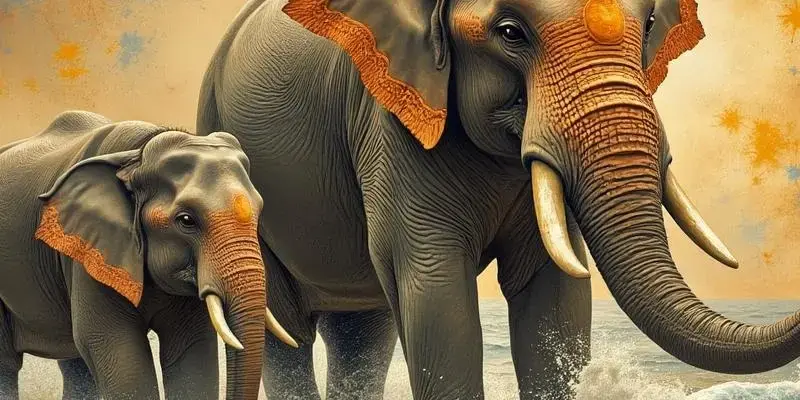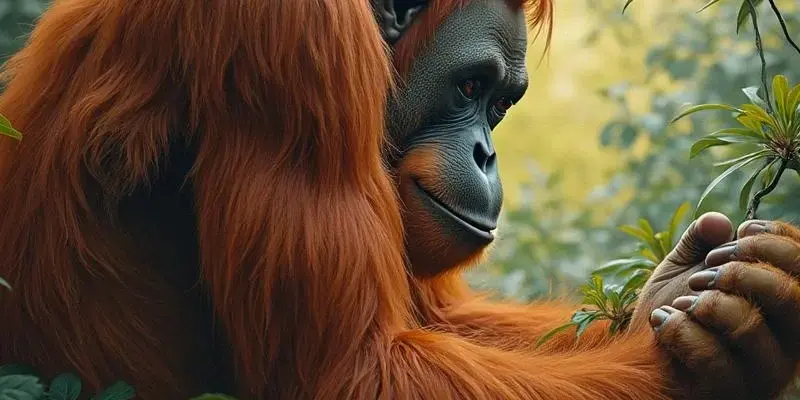Indian-elephant spiritual meaning

The Indian elephant represents a profound symbol of wisdom and power in Hindu spirituality, having been woven into the cultural and religious fabric of India for over 4,500 years. The majestic creature embodies fundamental virtues like strength, wisdom, and patience while serving as a living bridge between ancient traditions and contemporary spiritual practices.
Key Takeaways
- Indian elephants have been sacred symbols in Hinduism for more than 4,500 years
- Lord Ganesha, the elephant-headed deity, represents the removal of obstacles and auspicious beginnings
- Temple elephants are treated as living embodiments of divinity through ceremonial rituals
- Elephants symbolize cosmic balance with eight divine elephants believed to support the world
- Modern conservation efforts are increasingly viewed as a spiritual responsibility to preserve this sacred animal
The Sacred Elephant in Hindu Tradition
The spiritual significance of elephants in Indian culture dates back over four millennia. Archaeological discoveries have uncovered bronze elephant idols from 2500 BCE in Saraswati river bed excavations, confirming their early sacred status. These magnificent creatures aren’t merely animals in Hindu tradition—they represent divine intelligence, prosperity, and cosmic memory.
Elephants have become the identity of Indic civilization throughout history, appearing prominently on Indus Valley seals dating back to 2500 BCE. Their consistent presence across centuries demonstrates the remarkable continuity of reverence from ancient times to modern worship practices. In Hindu philosophy, elephants embody fundamental virtues that humans aspire to develop: strength without aggression, wisdom born of experience, loyalty to family, and patience in adversity.
Lord Ganesha: The Divine Elephant-Headed Deity
Lord Ganesha stands as the foremost embodiment of elephant symbolism in Hinduism. Known as the “Remover of Obstacles” (Vighnaharta), this beloved deity is traditionally worshipped before beginning any new venture or enterprise. Millions of devotees start their day by invoking Ganesha’s blessings, creating a powerful daily connection to this elephant-headed divinity.
The symbolic anatomy of Ganesha carries profound spiritual meanings. His large head with expansive ears represents infinite wisdom and the ability to be an attentive listener. His small eyes signify deep vision and discernment, while his broken tusk demonstrates the capacity to overcome opposition. Even in yoga practice, the Ganesh Mudra (hand gesture) emulates elephant-like stability and strength, bringing these qualities into the practitioner’s spiritual journey.
Cosmic Symbolism & Divine Attributes
In Indian spiritual tradition, elephants represent a constellation of positive qualities: good fortune, divine protection, material abundance, longevity, and wisdom. They serve as protectors of both home and family, bringing blessings to those who honor them. Their physical characteristics—tremendous size, intelligence, and social nature—mirror cosmic principles of power balanced with gentleness.
Elephants feature prominently in divine mythology. Gajalakshmi, a form of the goddess of wealth, is often depicted flanked by elephants who shower her with sacred water. Airavata, the magnificent white elephant, serves as the cosmic vehicle of Lord Indra. Perhaps most dramatically, Hindu cosmology describes eight divine elephants (Diggajas) positioned at the edges of the world, supporting the planet’s weight. When one elephant shifts position, it’s said to cause an earthquake—illustrating their connection to fundamental cosmic forces.
This spiritual symbolism extended into Asian elephant cultural significance across royal domains, with the Mauryan dynasty featuring elephants prominently on their punched marked coins, cementing their status as symbols of sovereign power and divine blessing.
Temple Elephants: Living Embodiments of Divinity
In Hindu temples across India, elephants receive extraordinary reverence as living carriers of divine blessings. Particularly in centers like Guruvayur Temple in Kerala and the temples of Kanchipuram, elephants participate in sacred processions that connect their physical presence to spiritual symbolism. These temple elephants create a tangible link between devotees and ancient spiritual concepts.
The daily rituals for temple elephants mirror the care given to deities. They undergo ceremonial bathing, receive blessed food offerings, and are adorned with sacred symbols and ornaments. This treatment reflects the profound belief that these animals embody divine qualities. Just as wild elephants create paths through dense forests, Ganesha is considered the remover of all obstacles—and temple elephants become living representations of this spiritual principle.
Spiritual Conservation: A Sacred Responsibility
The spiritual significance of elephants gives their conservation critical importance. Historical records indicate a dramatic decline from approximately 113,000 captive elephants during Moghul Emperor Jehangir’s reign to the current population of just 20,000-25,000 wild elephants in India. Since 1986, the Asian elephant has been listed as Endangered on the IUCN Red List, with populations declining by at least 50% over three elephant generations.
India’s remaining elephant population occupies roughly 163,000 km² of diverse habitats, comprising just 5% of the country’s land area. In response to this crisis, Project Elephant (established in 1992) created 25 Elephant Reserves throughout the animals’ traditional range, covering 58,000 km². However, population imbalances threaten both ecological and spiritual harmony—the normal male-to-female ratio of 1:12 has been distorted to as much as 1:100 in some areas, creating unsustainable conditions for these sacred creatures.
Modern Reverence in Everyday Life
Hindus have integrated elephant symbolism into daily life through diverse artistic and cultural expressions—from ancient cave paintings to contemporary textiles, coins, and decorative arts. These representations continue to evolve in modern contexts, appearing in fashion, home décor, and yoga practices while maintaining their spiritual significance.
The qualities associated with elephants—intelligence, sensitivity, loyalty, strength, determination, and power—continue to inspire modern spiritual practice. Their natural temperament, calm and patient unless provoked, provides a model for balanced human behavior. Temple elephants serve as living bridges between ancient traditions and contemporary spiritual life, helping modern devotees connect with timeless wisdom through direct experience of these magnificent creatures.
The Spiritual Path Forward
As South Asia’s human population grows, elephants face increasing habitat pressure, being confined to smaller areas and leading to major human-elephant conflicts. This ecological challenge carries spiritual dimensions, as traditional reverence must inform modern conservation approaches. Protecting elephants can be understood not merely as an environmental concern but as dharma—a sacred duty rooted in thousands of years of spiritual tradition.
The principle of Vighnaharta—removing obstacles—applies powerfully to elephant conservation. By honoring the 4,500-year spiritual connection between humans and elephants through concrete conservation action, modern practitioners can express their devotion in meaningful ways. The traditional temple model of reverence—where elephants are fed, bathed, and honored—provides a template for a broader societal approach to elephant protection that harmonizes spiritual values with ecological needs.
The article explores the deep spiritual significance of Indian elephants in Hindu culture, a relationship spanning over 4,500 years. Lord Ganesha, the elephant-headed deity, embodies wisdom and obstacle removal as a central figure in daily worship. Temple elephants receive special treatment as divine embodiments, participating in sacred rituals across India. They’re also connected to cosmic symbolism, with eight divine elephants believed to support the world. Conservation efforts have gained spiritual importance as wild elephant populations have dramatically declined from historical numbers, creating an urgent dharmic responsibility to protect these sacred creatures.
| Key Aspect | Significance |
|---|---|
| Historical Presence | 4,500+ years as sacred symbols, appearing in Indus Valley seals |
| Lord Ganesha | “Remover of Obstacles” worshipped before new ventures |
| Temple Elephants | Living divine embodiments receiving ritual care and adornment |
| Conservation Crisis | Population declined from 113,000 to 20,000-25,000, now endangered |
| Spiritual Values | Wisdom, strength, patience, loyalty, and cosmic balance |














